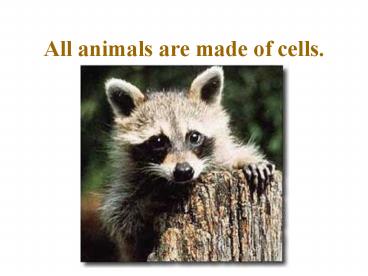All animals are made of cells. PowerPoint PPT Presentation
1 / 41
Title: All animals are made of cells.
1
All animals are made of cells.
2
We have observed single-celled animalslike this
paramecium.
3
These single-celled organisms carry on all of the
life functions that more complex animals do.
4
These include
- Respiration
- Movement
- Digestion
- Excretion
- Reproduction
- Response to
stimuli
5
All animal cells have certain parts.
6
We have also observed rotifers.
7
Rotifers are microscopic, but they are
multi-celled animalseven though they are smaller
than some single-celled animals.
8
They have cells that specialize into tissues. Two
examples include muscle and nerve cells. This
makes the rotifer a more complex organism.
9
Most of the animals with which we are familiar
are even more complex than the rotifer. These
more complex animals are multi-cellular and have
cells that specialize and are organized into
tissues that perform a specific job. Lets look
at a familiar animal to explain this.
10
(No Transcript)
11
Lets investigate to see some of the kinds of
cells in the human body.
12
Remember that the paramecium carries on life
functions with one cell. Human cells specialize
to perform these functions.
- Respiration
- Movement
- Digestion
- Excretion
- Reproduction
- Response to stimuli
13
Lets look at a couple of examples.
14
One important function of our bodies is that we
are able to move.
15
This helps us in many ways such as
- Letting us escape from danger
- Allowing us to get food
- Enabling us to move to a more comfortable
location - Enabling us to use tools to do things
16
Without our muscles, we couldnt
- Blink our eyes
- Swallow
- Walk or
- Talk
17
One of the main reasons we can move as we do is
because we have muscles.
18
Our muscles are made of millions of cells that
look like this.
19
Those cells form muscles.
20
More than 600 muscles of the body form the
muscular system.
21
Body systems are organized like this
cells tissues organs systems
22
muscle cells muscle tissue muscles
muscular system
23
Lets look at your nervous system.
24
There are many kinds of cells in your nervous
system.Nerve cells like this one receive
messages (stimuli) from your environment.
25
They carry that message from cell to cell toward
your brain.
26
Cells that receive messages may be in your -
- Skin
- Eyes
- Ears
- Nose
- Tongue
27
Most messages travel to the spinal cord on their
way to the brain.
28
The spinal cord is located in the middle of your
backbone. It is made of many nerve cells that
form nerve tissue.
29
The spinal cord relays messages to the brain. The
brain is made of millions of cells with
specialized jobs. The brain is the major organ of
the nervous system.
30
THE HUMAN BRAIN might just be the most complex
object in the world, and there is a lot we do not
know about it. It holds our memories, keeps our
heart beating, tells our muscles to move, and
allows us to learn and speak. It even allows us
to feel emotions and have fun.
31
Review
32
Animals are made of cells.
skin cells
33
Some kinds of animals, like the paramecium, are
single-celled.
34
Others, like the rotifer, are multi-celled.
35
Whether single or multi-celled, the cells carry
out all of the functions needed to keep the
animal alive.
36
In multi-celled animals, the cells specialize to
perform certain functions like the rotifer that
has muscle and nerve cells.
37
In more complex animals like humans,
specialization is very complex. Cells are
organized into tissues which are organized into
organs. All of these combined form a
system.cells tissues organs system
38
cells tissues organs systemnerve cell
nerve tissue brain nervous
system
39
cells tissues organs systemmuscle
cell muscle tissue biceps muscular
system
40
All animals are made of cells.
- Cells perform the functions necessary to keep
animals alive such taking in food and water,
giving off waste, moving, and reproducing. - Whether single-celled or multi-celled, they all
have the same needs, and the cells work to
provide those needs.
41
(No Transcript)

